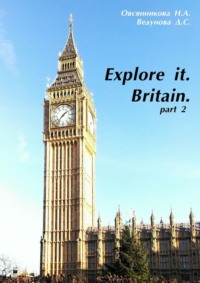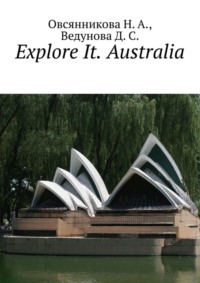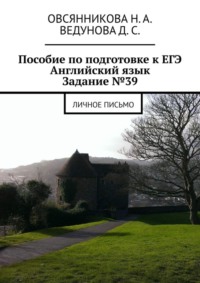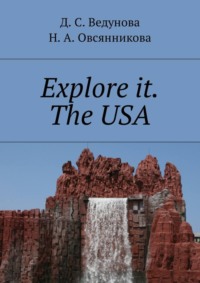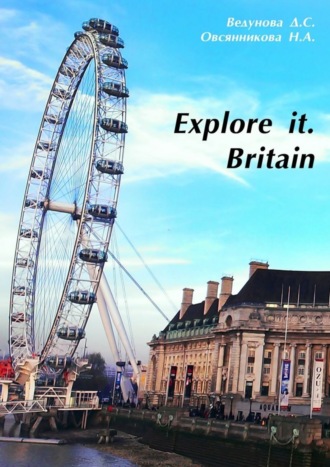
Полная версия
Explore it. Britain

Explore it. Britain
Н. А. Овсянникова
Д. С. Ведунова
© Н. А. Овсянникова, 2016
© Д. С. Ведунова, 2016
© Роман Алексеевич Голобоков, cover design, 2016
Created with intellectual publishing system Ridero
Geographical location and characteristics of the country
Features of the geographical location and the United Kingdom, located in the British Isles in the north-western coast of continental Europe, traditionally called (by the name of the largest island), the United Kingdom, and the name of its main part of England. Officially it is called the United Kingdom of Great Britain and Northern Ireland. In fact the UK has three historical and geographical areas: England, Wales and Scotland. The structure of the United Kingdom also includes Northern Ireland, which occupies the north-eastern part of the island of Ireland. This is the fourth region of the country. British Isles is the most extensive archipelago in Europe. It consists of two large islands – Great Britain and Ireland, separated by the Irish Sea, and another 5 thousand small islands, among which highlights the three island groups in the North: Hebrides, Orkney, Shetland and the Isle of Man, England and others. The UK is an archipelago of an irregular shape with a very diverse landscape and nature. The last one is due to the fact that the British Isles were once part of Europe, but were cut off from the mainland after the flooding of low-lying land, and now is the bottom of the North Sea and the English Channel. Northern Ireland, which is politically complements the United Kingdom, located on the second largest island of Ireland, and is the western extension of the Scottish mountains. These mountain areas are separated by a narrow channel of the North. The western coast of the island of Great Britain is rocky and steep, east is more gentle. The area of the UK is about 240842 km2 Most of it is the land, and the rest are rivers and lakes. England area is 129,634 km2, Wales is 20637 km2, Scotland is 77179 km2 and Northern Ireland is 13438 km2. Thus, England is bigger than the other countries of the United Kingdom, and has the largest population. These factors explain the dominance of England in British history. The southern end of the island of Great Britain is Cornwall peninsula – is at 50° NL (North latitude), and the most northern part of the archipelago of Shetland Islands are at 60° N.L. The length of the island of Great Britain from the north to south is 966 km. The British archipelago which is located on the Continental Shelf, is separated by the shallow North Sea from Sweden, Norway, Denmark and Germany and by the narrow English Channel (the British call it the English Channel) and Pas-de-Calais from France. Historically, the UK geographic features have influenced human settlement, migration, armed conquest and political union. They also identified the location and operation of industry, transport systems, agriculture, fishing industry, forests, energy and communications. Today, they continue to determine the life of the British, and in addition, they are closely related to public concern about the environment and wildlife. England (population – 48.2 million people) consists mainly of hilly or flat lowland areas with several mountain zones in the north and south-east. But the low hills stretch across most of the country, interspersed with low-lying lands and plains. The population is concentrated mainly around the city of London and even in the south-east of England, west of Birmingham, Leeds, Bradford and Sheffield, north-western industrial Liverpool and Manchester and the north-east of Newcastle and Sunderland. Wales (population – 2.9 million people) is a mountainous country with a territory stretching across the mountains and hills, often terminates in the deep valleys by riverbeds. These mountains gradually decrease and become the highest hills in the east of England. The highest mountains of Wales, located in the north-west, where Mount Snowdon reaches 1085 m. Lowland lands are limited by narrow coastal zones and river valleys in South Wales, where two-thirds of the Welsh population live. In the past, the Welsh mountain terrain hampered the war, agriculture and human settlement. Scotland (population – 5.1 million people) can be divided into three main parts. The first part is the north-western and central mountains with a lot of islands in the western and northern coasts. These lands are densely populated, and account for half of the whole territory of Scotland. The second part is the central low-lying lands, which make up one-fifth of all the Scottish territory, and three-quarters of the population of Scotland, most of the industrial and commercial centers and arable land. The third part is the southern hills, which include a range of hills stretching to the border with England. The highest mountain in Scotland is Ben Nevis (1342 m), which is also the highest mountain of Great Britain. Northern Ireland (population – 1.6 million people) is separated by only 21 kilometers from the Scottish coast, that was the reason for the migration of peoples in the distant past. Since the partition of Ireland in 1921 to the south and west, it borders with the Republic of Ireland. To the north there is a mountainous coast, in the center, close to the south there is fertile valley, and there are the mountains to the west, north-east and south-east.
Questions on the basis of the material studied:
1. What is the total population of the UK?
2. What is the full official name of the UK?
England
England is the most major historical and administrative part of the United Kingdom of Great Britain and Northern Ireland. England’s population is 84% of the total UK population. The capital of England is London, the largest city in the UK and the European Union. England is the place of origin of the English language and the Church of England, and English law forms the basis of the legal systems of many countries. In addition, London was the center of the British Empire, and the country was the birthplace of the Industrial Revolution. Britain was the first industrialized country in the world, and a country with parliamentary democracy, constitutional, governmental and legal innovations that have been adopted by other nations and countries. The Kingdom of England, including the Principality of Wales, was a separate state until 1 May 1707, when united with Scotland in the United Kingdom. England received its name in honor of the Angles, Germanic tribe settled in Britain in the V and VI centuries BC. Some historians believe that this tribe was descended from immigrants who lived on the Angeln peninsula, part of the Jutland peninsula, which is today part of northern Germany. The first mention of England was in the work entitled “Germany”, written in 98 BC. by Roman historian Tacitus. According to the Oxford English Dictionary, the earliest known mention of the term “England” in relation to the southern part of the island of Great Britain refers to the year 897.
England occupies two thirds of the island of Great Britain. It has borders with Scotland and Wales. The landscape of England consists mainly of gentle hills to the north where it becomes more mountainous. Mining and flat land conditionally divided by a line drawn between the mouth of the River Tees (Teesside) to the north-east and the mouth of the river Ex (Devon) in the southwest. To the east there is a low-lying marshland, which was mainly drained for agricultural use.
The six largest cities of England: London, Birmingham, Leeds, Sheffield, Liverpool and Manchester.
The territory of modern England at the time of the invasion of Julius Caesar 55 BC., as a century later, at the time of capture of the Emperor Claudius, it was inhabited by Celtic tribes, called the Britons. As a result, capturing the entire southern part of the island (modern England and Wales) became part of the Roman Empire until its collapse in the V century BC.
Without the help of the Roman legions Roman Britain could not long resist the barbarians-Germans, appeared in V – VI centuries, as evidenced by the chronicles, at the invitation of the Britons themselves, who hoped to use them to protect themselves from the Celtic tribes from the north – the Picts and the Scots. There were three groups of invaders – the Jutes, Saxons and the Angles. Having mastered the territory of the Britons, the Germans began to press them on the territory of Wales and Cornwall. Over time, some of the kingdom, which formed, in particular, “the Anglo-Saxon Heptarchy” (alliance of the seven kingdoms). From time to time one of the seven Anglo-Saxon kings, called “Britvalda”, which can be loosely translated as “Ruler of Britain” gained control over most of England – so it is hard to tell the time when England was finally united. According to some descriptions, the association has come together with the invasion of Danish Vikings, captured the eastern part of England. Egbert, king of Wessex (died 839), often referred to as the first king of all England, although the title “King of England” came just two generations later – during the reign of Alfred the Great (871—899).
William I the Conqueror
Some historians are beginning to count the rulers with the Norman Conquest in 1066, numbering of English monarchs also use the event as a reference point (eg, Edward I, crowned in the XIII century, it was not the first king of the same name, but he was first to Edward since 1066). But William the Conqueror didn’t established and didn’t unite the country, but only took existing England by a Franco-Norman control.
At the end of the XIII century the neighboring principality of Wales was finally conquered by England and became the part of the English kingdom. History of England as an independent state goes through the Middle Ages and the Renaissance to the reign of Elizabeth I, the last queen of the Tudor dynasty, which reigned after James I, the former King of Scotland under the name of James VI. England Union and Scotland has been added a century later the Act of Union (1707), which finally united England and Scotland in the United Kingdom. After the reforms of the 1990s in Northern Ireland, Wales and Scotland, England remained the only one of the components of the UK, not having its own parliament and government. Parliament functions of England are performed by the UK Parliament, the functions of government by the government of the United Kingdom. Executive power is in charge of the territory of England and is headed by the Prime Minister of Great Britain.
The idea of an independent parliament is supported by many leaders of the Conservative Party, while the Labour Party believes that the creation of independent authorities in the largest part of the kingdom will lead to a sharp decrease in the role of Scotland, Wales and Northern Ireland, and is fraught with the collapse of the state. Historically, the largest administrative education in England was the county. These formations have arisen from older, pre-existing associations of England: kingdoms (as Sussex and Essex), duchies (like Yorkshire, Cornwall and Lancashire), or simply land parcels, which were awarded the nobility, such as Berkshire. Until 1867, they were divided into smaller formations, called hundreds. Municipality within the county after the political unification virtually absent, so the county boundaries have not been clearly defined and played a little or no role at all. After the industrial revolution the metropolitan counties were formed as a result of major industrial centers, which became the centers of major cities. Currently, Britain has 9 regions and 48 counties. Agriculture, manufacturing, high-tech industry and the sports industry play an important role in the British economy.
Questions on the basis of the material studied:
1. When were England and Scotland united into one kingdom?
2. What plays an important role in the British economy?
Scotland
Scotland is famous for its cold, endless rain, a little gloomy beauty of picturesque plains, covered with heather uplands, old castles, known worldwide for its Loch Ness Monster, Scottish bagpipe and cloth.
As everyone knows, Scotland is a part of a modern Britain, at the same time it is a very special part of it, which occupies the north of the country and adjacent islands (more precisely, the 787 islands belonging to the group of the Hebrides, Orkney and Shetland), its area is about one-third the area of the UK (787.7 km2), and the population – about one-tenth (5.1 mln. people). Scotland is washed by the North Sea in the east and the Atlantic Ocean in the north- west. The main city is Edinburgh.
Official language is English. In the north of Scotland and the islands people speak Gaelic – Scots language of Celtic origin. Scotland has some autonomous rights – its legal and educational systems, banknotes are printed on special designs and they must be accepted in England. There is the Scottish Parliament in Edinburgh, but this prerogative was granted to Scotland only in 1999. Scotland has its own government. But the head of state for Scotland is the Queen Elizabeth. Patron Saint of Scotland is Andrew (St. Andrew), and St. Andrew’s Day is celebrated worldwide on the 30 of November.
National flag of Scotland is St. Andrew’s, a white cross on a blue background, has become a symbol of national independence. Biblical legend has it that St. Andrew was crucified by the Romans on a diagonal cross, because the cross on the flag of St. Andrew is located diagonally. St. Andrew’s flag appeared in Scotland in the XII century. The second national flag, also belonging to Scotland – Royal flag depicting the rampant lion (called “Lord of the lion”).
Scottish Highlands occupies the north and north-west; in the central plains they are located in the south. There are 26 rivers there, the largest three are: the Clyde, the Forth and the Tay, they provide supplies to Glasgow, Edinburgh and Dundee. Scotland is known for its lakes. The most famous is the Loch Ness.
History of Scotland.
Scotland was inhabited by the Picts and the Gauls, in the V – VI centuries. The Scots came here from Ireland and gave the name to this place (the country of the Scots). After several centuries of struggle against the Picts in 843, Scots were able to crown their king Kenneth Mc Alpina. In the XI century there was a social, political and religious revolution – the Scottish King Malcolm Canmore married to the English princess Margaret. He wanted the country to have the English language and traditions. At that time, strong trade ties between the two countries were established. By the XI century Scottish kingdom, uniting the territory of several powerful clans was formed. After the Norman conquest of England (1066) Scotland culture has been influenced by French culture.
Scotland flourished before the XIV century, until the English King Edward I decided to subordinate it to the English crown. Over the next three centuries Scotland remained independent, but poor country. The struggle against British rule led by Robert the Bruce, the Scottish hero, who was crowned in Skoukone and defeated the English at Bannockburn. After the battle, Britain recognized the independence of Scotland. The dynasty of the Stuarts started in 1371, in Scotland.
In 1603, England and Scotland were united, but not as a result of the war, but with the help of those who wanted to see England Catholic again. So the Scottish King James I, the son of Mary Stuart, became a king of England and Scotland.
The Industrial Revolution contributed to the development of cotton production and shipbuilding, as well as trade prosperity. However, it followed the crisis of overpopulation and famine caused many Scots to leave their country. Scots immigrated to North America, New Zealand and Australia.
The main industries of Scotland are banking, finance, transport equipment, steel production, oil and gas, production and sale of whiskey, and tourism.
Scottish National clothes. The world-famous Scottish kilt has been worn by mountaineers for many centuries. Kilt is men’s clothing. Women wore a national dress which is a pleated skirt, which has a strictly defined length – no less and no more than mid-knee.
Scotland Cities. Edinburgh became the capital of Scotland, only in the XII century. Prior to this, the Scottish kings were crowned at Scone first, then in Dunfermline. Edinburgh is located in the extraordinarily picturesque location between the sea and the hills. One of the main attractions is the ancient castle made of basalt. There is the oldest building in Edinburgh – the chapel of Queen Margaret of Scotland in the area of the castle. The Scottish crown, scepter and sword of state are kept here. They are considered to be one of the most ancient royal regalia in Europe. The castle is very popular.
The Royal Palace of Holyroodhouse is the official residence of the Queen during her stay in Scotland. The palace was built on the orders of King James IV in 1498. Mary of Scotland lived here. For a long time, the palace was abandoned. King George IV brought it back to life. A fine collection of French and Flemish tapestries is assembled here. The city has many areas where people can relax, visit the many pubs and restaurants.
Questions on the basis of the material studied:
1. Who is the head of state in Scotland?
2. How long has Scotland got its Parliament?
Wales
Wales is located in the west of the island of Great Britain. In the west and north it is bordered by the Irish Sea (Irish Sea – Môr Iwerddon, St. George’s Channel), in the south it is bordered by the mouth of the River Severn (Bristol Channel). To the east its boundary is defined by the administrative division of the United Kingdom. Most of the territory is occupied by the various Welsh mountains. The main are the mountains of Wales (Cambrian Mountains) with the highest points of Snowdon (Snowdon – Yr Wyddfa). This mountain is 1085 m above sea level, Cader Idris (Cadair Idris) is 892 m and Plinlimon (Plynlimon) is 752 m. South West Wales is comparatively low, hilly region, and to the south there are the mountains of the Brecon Beacons (Brecon Beacons – Bannau Brycheiniog). This area is relatively young compared to Cambrian Mountains and contain significant reserves of coal. Brecon Beacons reach a height of 886 m above sea level. Along the border with England there is a number of minor elevations: Berwin Mountains, Beacon Hill, Radnor Forest. Other plains are located on the island of Anglesey (Ynys Môn), in the valley of Glamorgan and Gower peninsula (Gower – Gŵyr) in the south and in the extreme south-west, Pembrokeshire (Pemrokeshire – Sir Benfro).
Wales is open to winds from the Atlantic Ocean, so the climate there has some features of the sea. The coastline is an almost perfect half circle, bounded in the north by the peninsula of Llyn (Lleyn – Llŷn), and in the south there is a large peninsula that ends in the southwest of St. David’s Head (Penmaen Dewi). There are up to 1,270 mm of precipitation in the west coast, while to the east of the mountains these figures are somewhat lower (up to 723 mm / year), and in the mountains themselves this numbers are higher (up to 2540 mm / year). The average July temperature is 15.6°C, in January it’s 5.6°C.
Most of the territory used to be covered with forests of Wales, but now much of it is reduced. Nevertheless Wales is one of the most beautiful regions of the UK. Nearly a quarter of its territory is declared either the National Park (Snowdonia (Eryri), Brecon Beacons), or an area of the outstanding natural beauty.
Basic information
Area: 20 764 km2. Wales stretches from north to south for 240 km and from west to east for 185 km.
Population: 2,903,085 people.
Official name: Principality of Wales – Tywysogaeth Cymru
The unofficial name: Wales – Cymru
The Flag has no special name. The heraldic description: Passau red dragon on white and green box (with minor variations).it was officially approved in 1959.
Coat: There’s no official coat of arms in Wales, but there’s a royal badge (Bathodyn Brenhinol Cymru).
Officially, the head of the Principality of Wales is the Prince of Wales. In the center of the shield of his coat of arms there is the coat of arms of the Principality of Wales.
Motto: Y Ddraig Goch Ddyry Cychwyn “Red Dragon leads forward.” An informal motto also distributed Cymru am byth – “Wales forever.” The motto of the Prince of Wales – Ich Dien “I serve”
Plant: leeks.
Anthem: Hen Wlad Fy Nhadau – Land of My Fathers
Patron saints: Dewi Sant – St. David (holiday – March 1)
National holiday: 1 of March Dydd Gŵyl Dewi – St. David’s Day
Capital: Cardiff – Caerdydd (1955)
Official language: English. According to the Act on Welsh. The Welsh language is equalized by the law in all areas of public life in Wales.
Government: National Assembly for Wales – 9Cynulliad Genedlaethol Cymru). The Wales Office (Swyddfa Cymru), headed by the State Secretary for Wales is in London.
Symbols
The Flag of Wales. The dragon was used in Britain since Roman times. Initially, it was depicted on the banners of the Romans. After that it was used not only by the Britons but also by the Saxons and the Scots. Britons had a red dragon, but in the Middle Ages, one could meet it in a variety of variations on the theme of fire (red, fire, gold). White and green are the colors of the Tudors. However, these colors were associated with Wales in the past. In 1807 the Royal Badge of Wales was declared a red dragon on a green hill on a white field. In 1953 the sign was changed to a red dragon in a white and green field shield was girded with a ribbon with the motto of Y Ddraig Goch Ddyry Cychwyn and crowned. Flag of Wales was declared a royal sign on a white field. In 1959, the Wales flag adopted its present appearance.
Questions on the basis of the material studied:
1. When was the Welsh Flag officially approved?
2. Is there the Welsh language?
Northern ireland
Northern Ireland, a part of the United Kingdom of Great Britain and Northern Ireland. It is located in the northeast of Ireland. Sometimes the name “Ulster” is used, as Northern Ireland occupies most of the territory of this historic province. It includes six counties: Antrim, Armagh, Down, Fermanagh, Londonderry (Derry) and Tyrone, and 26 districts. The hills surround the central plain. There is the lake Lough Neagh, the largest in the British Isles. The coastline is characterized by pronounced fragmentation and extends from the Gulf of Lough Foyle to the Mourne Mountains. The coastal landscape is very picturesque. The climate of Northern Ireland is temperate with mild winters and cool summers. Rainfall is quite large, and falls more than in the east to the west of precipitation.
Although Northern Ireland has an area of 14,138 km2 or 1/6 of the entire area of Ireland there lives a third of the population of the island. The highest level of industrial development is also a feature of Northern Ireland. The capital city of Belfast is the main industrial center. Northern Ireland has traditionally been the agricultural province, but at the moment in terms of income and number of employees industry is ahead of agriculture.
Northern Ireland has a population of 1570000 people. Approximately half of them live in cities. The largest city is Belfast (281000). It is followed by Londonderry, or Derry (68000). There are also high birth rate and lifespan.
Religion and language. Approximately 3/5 of the population of Northern Ireland are Protestants and more than 2/5 are Catholics. The latter form the majority of population in the town of Londonderry and the counties of Fermanagh and Tyrone.
Most Protestants favor the continuation of the union of Northern Ireland with the United Kingdom, while Catholics prefer to unite with the Irish Republic.
The modern population still reflects the effects of the settlement of Ireland by the English and the Scots in the 17th century. This campaign was conducted under the British colonization policy. The land was alienated from Irish landowners and passed to the English and Scottish settlers. The inhabitants of the eastern regions of Northern Ireland show a great similarity in language and customs with the inhabitants of Scottish plains, while in the south and west some signs of the English origin can be traced



